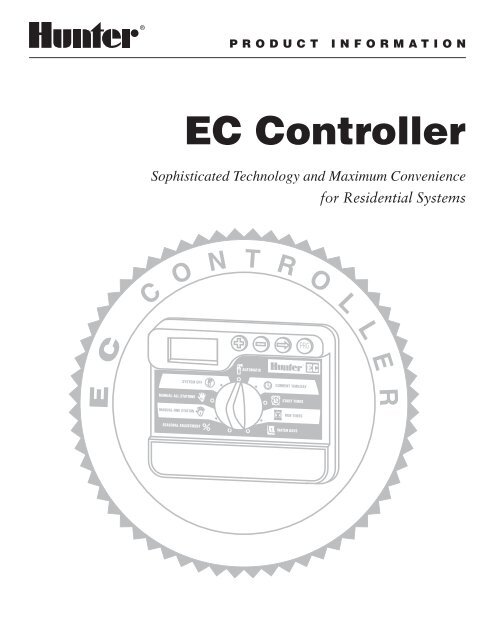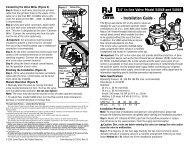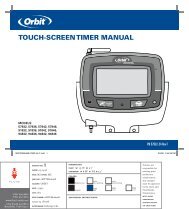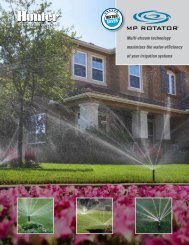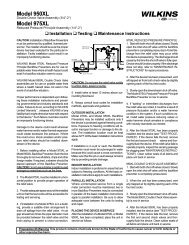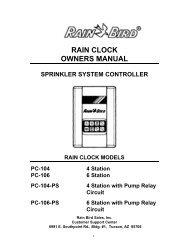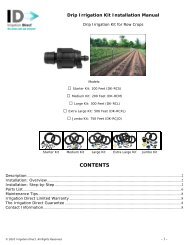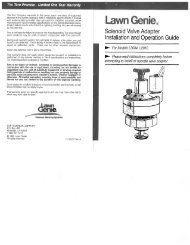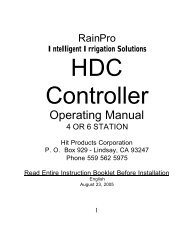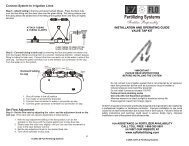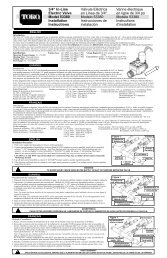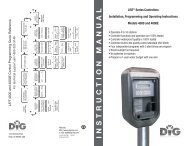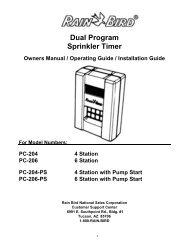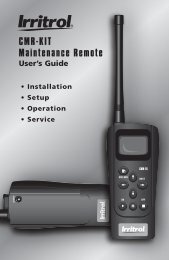Hunter EC Controller Troubleshooting Guide and ... - Irrigation Direct
Hunter EC Controller Troubleshooting Guide and ... - Irrigation Direct
Hunter EC Controller Troubleshooting Guide and ... - Irrigation Direct
Create successful ePaper yourself
Turn your PDF publications into a flip-book with our unique Google optimized e-Paper software.
®<br />
P R O D U C T I N F O R M A T I O N<br />
<strong>EC</strong> <strong>Controller</strong><br />
Sophisticated Technology <strong>and</strong> Maximum Convenience<br />
for Residential Systems<br />
C<br />
O<br />
N<br />
T<br />
R<br />
O<br />
L<br />
C<br />
L<br />
AUTOMATIC<br />
<strong>EC</strong><br />
E<br />
SYSTEM OFF<br />
CURRENT TIME/DAY<br />
R<br />
E<br />
MANUAL-ALL STATIONS ALL<br />
ALL<br />
START TIMES<br />
MANUAL-ONE STATION<br />
1<br />
RUN TIMES<br />
SEASONAL ADJUSTMENT<br />
WATER DAYS
®<br />
TABLE OF CONTENTS<br />
Product Overview ..........................................................................................3<br />
Product Features <strong>and</strong> Beneits........................................................................4<br />
Product Comparisons...................................................................................10<br />
Technical Information..................................................................................12<br />
Installation....................................................................................................13<br />
Programming................................................................................................17<br />
<strong>Troubleshooting</strong> <strong>Guide</strong> ................................................................................26<br />
2
ALL<br />
R<br />
PRODUCT OVERVIEW<br />
<strong>Hunter</strong> presents a controller created<br />
speciically for the international market.<br />
A masterpiece of modern technology that<br />
brings together the most desirable features,<br />
bundles them in a small, attractive package,<br />
<strong>and</strong> makes everything simple <strong>and</strong><br />
easy to use.<br />
The <strong>EC</strong> is designed for those who donʼt<br />
want a big controller, but do want one with<br />
all the features that meet their irrigation<br />
requirements. Available in compact 2-,<br />
4- <strong>and</strong> 6-station indoor models <strong>and</strong> 4- <strong>and</strong><br />
6-station outdoor models, the <strong>EC</strong> offers<br />
all the features you would expect to ind<br />
only on more expensive units – on-screen<br />
watering budgeting for seasonal adjustment,<br />
interval watering options, station<br />
delay, one-touch manual start <strong>and</strong> advance<br />
<strong>and</strong> non-volatile memory (plus, the outdoor<br />
models boast a sturdy protective<br />
cabinet that includes a lockable case).<br />
Best of all, no controller is simpler to<br />
install <strong>and</strong> program. Both the faceplate<br />
<strong>and</strong> the easy-to-read LCD display feature<br />
internationally-recognized icons that make<br />
programming a snap, regardless of the<br />
language you speak.<br />
The <strong>EC</strong> controller. Just the latest<br />
example of how <strong>Hunter</strong> makes advanced<br />
engineering simple.<br />
C<br />
O<br />
N<br />
T<br />
R<br />
O<br />
L<br />
L<br />
C<br />
AUTOMATIC<br />
<strong>EC</strong><br />
E<br />
SYSTEM OFF<br />
CURRENT TIME/DAY<br />
E<br />
MANUAL-ALL STATIONS ALL<br />
START TIMES<br />
MANUAL-ONE STATION<br />
1<br />
1<br />
RUN TIMES<br />
SEASONAL ADJUSTMENT<br />
WATER DAYS<br />
3
®<br />
PRODUCT FEATURES<br />
AND BENEFITS<br />
Outdoor or Indoor Models Available<br />
A versatile controller, covering the needs<br />
of all installations<br />
The <strong>EC</strong> is a very affordable controller<br />
offered as an indoor model for installations<br />
where protection from the elements is<br />
available or as an outdoor model when the<br />
need for weather resistance is required.<br />
2-, 4- or 6-Station Models<br />
Best value for residential, only buy the<br />
stations you need<br />
<strong>Hunter</strong> is a leader in fulilling customer<br />
wishes. The <strong>EC</strong> controller is just one<br />
of the latest in a long history of quality<br />
irrigation products. For those irrigation<br />
systems which may only include a small<br />
low-volume zone or two, the <strong>EC</strong> 2-<br />
station is the perfect choice. For small<br />
residential systems requiring zones for<br />
a number of different plant types, or<br />
for areas requiring a number of zones<br />
because of reduced design capacity, the<br />
<strong>EC</strong> 4- or 6-station is the best choice.<br />
Large LCD with Interactive Icons<br />
Internationally recognized<br />
programming icons<br />
The large LCD<br />
display with<br />
interactive<br />
icons simpliies<br />
programming by<br />
using internationally recognized symbols<br />
for programming functions. Also, the<br />
display is easy to read <strong>and</strong> verify, making<br />
the entries easy to underst<strong>and</strong> in any<br />
language.<br />
1. Main Display – Indicates all<br />
programmed information.<br />
2. Run Times – Icon indicates when Run<br />
Times are being set.<br />
14<br />
3 4<br />
5<br />
2<br />
11 12 6<br />
3. Start Times – Icon indicates when<br />
Start Times are being set.<br />
4. Station Number – Indicates currently<br />
selected station number.<br />
5. Program Designator – Identiies<br />
program in use A, B, or C.<br />
6. Day of the Week – Day of the week is<br />
indicated by number 1 to 7.<br />
7. Flashing Sprinkler – Indicates that<br />
watering is occurring.<br />
8. Crossed Sprinkler – Indicates that<br />
watering is suspended.<br />
9. Umbrella – Indicates Rain Sensor is<br />
suspending irrigation.<br />
10. Percent – Indicates that Seasonal<br />
Adjustment is being made.<br />
11. Rain Drop – Indicates watering will<br />
occur on that selected day.<br />
12. Crossed Rain Drop – Indicates<br />
watering will NOT occur on<br />
selected day.<br />
13. Calendar – Indicates interval watering<br />
schedule is being programmed.<br />
14. Bars – Indicate seasonal adjust/water<br />
budgeting percentage.<br />
13<br />
1<br />
10<br />
9<br />
7<br />
8<br />
4
Electronic Short Circuit Protection<br />
No fuses to worry about<br />
The <strong>EC</strong> is equipped with a circuit overload<br />
protection system. The electronic short<br />
circuit protection system detects a high<br />
current path (short) through an operating<br />
station. (The<br />
most common<br />
causes of<br />
“shorts” are<br />
faulty solenoids<br />
or when a bare valve common wire<br />
touches a bare station control wire) When<br />
a short circuit is detected on a station,<br />
instead of blowing a fuse which would<br />
shut down the entire irrigation system, the<br />
controller will skip over that station <strong>and</strong><br />
continue to water the rest of the zones in<br />
the program. The controller will indicate<br />
what zone is shorting by showing the<br />
station number followed by<br />
ERR in the LCD display. To<br />
remove the ERR message<br />
from the display, just turn the<br />
dial or push any button. The<br />
controller will continue to<br />
“jump over” that zone during<br />
every watering until the zone<br />
is repaired.<br />
Primary Surge Protection<br />
Microcircuits protected from<br />
electrical spikes<br />
The <strong>EC</strong> is equipped with an electronic<br />
component called a MOV (Metal-<br />
Oxide Varistor). The MOV is designed<br />
to shunt electrical surges away from<br />
microcircuits through a grounding<br />
circuit. The <strong>EC</strong> uses a MOV to protect<br />
the controller from minor primary power<br />
surges when the controller is properly<br />
grounded.<br />
Non-Volatile Memory<br />
Holds programs indeinitely; excellent<br />
insurance against unreliable power<br />
The <strong>EC</strong> has what every user of electronic<br />
controllers has wished for. The ability to<br />
keep programs in memory without the<br />
use of a backup battery. In the event of a<br />
power failure or if AC power is suspended<br />
from the controller by the user, the <strong>EC</strong>ʼs<br />
non-volatile memory will maintain the<br />
calendar date <strong>and</strong> program forever,<br />
without the use of a 9-volt battery installed<br />
in the controller. Normal watering will<br />
resume when AC power is restored.<br />
No Battery Required<br />
Maintain time of day up to four weeks<br />
The circuitry of the <strong>EC</strong> has such low<br />
power consumption that the controller<br />
will accurately track the time of day for<br />
up to four weeks after AC power has<br />
been removed from the controller by the<br />
user or in the event of<br />
a power outage. This<br />
timekeeping occurs<br />
without the use of a<br />
9-volt battery installed<br />
in the controller. When<br />
power is restored the<br />
controller will continue to water, right on<br />
schedule. Also, when power is restored<br />
the controller will recharge its circuits to<br />
allow another four weeks of time keeping.<br />
5
®<br />
PRODUCT FEATURES<br />
AND BENEFITS (cont.)<br />
Intuitive Dial Programming<br />
For easy program entry<br />
For contractors <strong>and</strong> homeowners alike, the<br />
<strong>EC</strong> provides step by step programming.<br />
No complicated entry functions or<br />
repetitive keystrokes. Just turn the dial to<br />
the section of the program that needs to be<br />
changed <strong>and</strong> use the plus, minus <strong>and</strong> next<br />
buttons to make the adjustments. No other<br />
programming method is easier – in any<br />
language.<br />
Three Programs (A, B, C) with Multiple<br />
Start Times<br />
Different watering requirements are met<br />
with independent programming<br />
The <strong>EC</strong> allows different irrigation<br />
applications using the three completely<br />
independent programs. This important<br />
feature can be used for various types of<br />
plants that have separate day watering<br />
requirements. Each program has the ability<br />
to water up to four start times per day. The<br />
user has complete lexibility with watering<br />
schedules for new seed or sod lawns,<br />
multiple cycles for low iniltration-rate<br />
soils, slopes, morning or evening irrigation<br />
<strong>and</strong> other watering window restrictions.<br />
Seasonal Adjustment/Water Budgeting<br />
Changing run times could not be easier,<br />
from 10% to 150%<br />
The seasonal adjustment setting on the dial<br />
allows the user to make global changes to<br />
the run times of each zone from 10% to<br />
150% percent of the original programmed<br />
run time. This feature is perfect for making<br />
small changes that are necessary as the<br />
weather changes, without reprogramming<br />
the entire controller. A bar<br />
graph in the large LCD display<br />
lets the programmer know at a<br />
glance at what percent from the<br />
original settings the controller<br />
is operating the station run<br />
times. An excellent feature built into<br />
the seasonal adjustment is the ability to<br />
immediately view the newly adjusted<br />
run times when the rotary dial is turned<br />
to the Set Station Run Times position.<br />
Note: The controller should always<br />
be initially programmed in the seasonal<br />
adjustment in the 100% position.<br />
<strong>Controller</strong> Programming Without<br />
AC Power<br />
Maximum convenience for programming<br />
using a 9-volt battery<br />
With a 9-volt battery hooked up, the<br />
<strong>EC</strong> has the ability to be<br />
programmed (including time<br />
<strong>and</strong> day) before installation or<br />
in the absence of AC power.<br />
This ability comes from<br />
circuitry within the controller<br />
using the power supplied<br />
by the 9-volt battery. After<br />
programming, the battery<br />
may be removed from the<br />
controller if desired because<br />
the controller is designed to store all<br />
programming indeinitely within its<br />
memory.<br />
Assign Zones to Any or All Programs<br />
Complete versatility for any watering<br />
requirement<br />
Any station can be assigned to any or<br />
all programs in the <strong>EC</strong>, making the <strong>EC</strong><br />
a truly versatile controller. This allows<br />
zones to have more than one watering<br />
schedule if required by the l<strong>and</strong>scape.<br />
SYSTEM OFF<br />
MANUAL-ALL STATIONS ALL<br />
MANUAL-ONE STATION<br />
SEASONAL ADJUSTMENT<br />
ALL<br />
1<br />
AUTOMATIC<br />
CURRENT TIME/DAY<br />
START TIMES<br />
RUN TIMES<br />
WATER DAYS<br />
<strong>EC</strong><br />
6
One Touch Manual Start <strong>and</strong> Rapid<br />
Advance<br />
Simple operation for a quick check of zones<br />
A new feature that <strong>Hunter</strong> has incorporated<br />
into the <strong>EC</strong> is called the One Touch Start<br />
<strong>and</strong> Rapid Manual<br />
Advance.<br />
It increases userfriendliness<br />
of the<br />
controller by using<br />
fewer steps to<br />
activate stations. This<br />
feature is great for a<br />
quick cycle when extra watering is needed<br />
or if you would like to scroll through the<br />
stations to inspect the system.<br />
Single Station Manual Start<br />
If all that is needed is a little extra on a<br />
single zone!<br />
Many times throughout the year <strong>and</strong> for<br />
many reasons, the user will want to add<br />
extra water to a particular zone. Wateringin<br />
fertilization <strong>and</strong> pesticides<br />
into the soil or spot seeding are<br />
just a few. With single station<br />
manual start, the <strong>EC</strong> is able to<br />
accomplish that task. Just turn<br />
the dial to Manual-One Station,<br />
use the arrow button to move<br />
to the desired station, then turn<br />
the dial to the Run position.<br />
The user may also increase or<br />
decrease the run time setting<br />
if preferred. After the zone<br />
is inished, the controller will return to<br />
automatic mode with its original schedule,<br />
even if modiied for the manual operation.<br />
AM/PM or 24 Hour Clock Settings<br />
Choose your favorite method<br />
of timekeeping<br />
The <strong>EC</strong> allows<br />
the user to select<br />
the option of<br />
operating the<br />
controller in<br />
AM/PM mode or<br />
24-hour mode.<br />
Many electronic<br />
controllers are<br />
dependent on the cycles of electricity<br />
to determine whether the controller will<br />
operate in the AM/PM or 24-hour clock<br />
setting. When the electricity is at 60 Hz,<br />
the controller will operate in AM/PM<br />
mode <strong>and</strong> when the electricity is at 50<br />
Hz, the controller will operate in 24-hour<br />
mode. The <strong>EC</strong> is designed to best it the<br />
need of the user without regard to the<br />
Hz cycles.<br />
Choice of Independent Day<br />
Scheduling Options<br />
Days of the week or 31 day interval for<br />
maximum lexibility<br />
The day schedule in program A, B or C<br />
may be set up independently from each<br />
other. In each program, the choice of<br />
Day of the Week or a watering interval<br />
up to 31 days apart may be selected. This<br />
allows the user to water on certain days of<br />
the week such<br />
as Monday,<br />
Wednesday <strong>and</strong><br />
Friday or water<br />
on a repeating<br />
day cycle (interval) such as every third<br />
day, in any of the programs.<br />
7
®<br />
PRODUCT FEATURES<br />
AND BENEFITS (cont.)<br />
Programmable Rain Delay (0 to 7 Days)<br />
No need to return to the controller to turn<br />
it back on<br />
The <strong>EC</strong> allows<br />
you to turn off<br />
the controller for<br />
a predetermined<br />
period of time<br />
(1 to 7 days) during rainy weather. All<br />
programs are affected, as this delay is<br />
global. After the speciied period has<br />
elasped, the controller will return to<br />
automatic mode <strong>and</strong> water as scheduled.<br />
This delay feature is very convenient in<br />
residential systems, when the operator<br />
uses this delay feature, thereʼs no need to<br />
worry about remembering the controller<br />
has been turned off. This delay is accessed<br />
by turning the dial to SYSTEM OFF, wait<br />
four seconds <strong>and</strong> then push the button to<br />
the number of days of delay.<br />
Master Valve/Pump Start Relay Circuit<br />
Compatible with <strong>Hunter</strong> PSR (Pump Start<br />
Relay) <strong>and</strong> other industry relays<br />
A master valve or <strong>Hunter</strong> PSR pump<br />
start relay can be activated with 24 VAC<br />
power by connecting the wires to the C<br />
(common) <strong>and</strong> P (pump/master valve)<br />
terminals.<br />
Note: maximum allowable amperage of<br />
the relay is set at .28 amps.<br />
Programmable Delay Between Stations<br />
Slow closing valves <strong>and</strong> water well<br />
recovery will never be an issue<br />
A programmable delay between stations<br />
solves the problem of a slow closing valve<br />
causing a hydraulic overload condition.<br />
The delay is programmable up to 100<br />
seconds. To access the delay: while the<br />
dial is at the AUTOMATIC position, push<br />
the button then rotate the dial the RUN<br />
TIMES position. Push the or button<br />
to increase or decrease to amount of time,<br />
up to 100 seconds. Note: The MV circuit<br />
will stay hot only for the irst minute of<br />
the programmed delay.<br />
Up to Four Hour Run Times<br />
Allows accurate watering for all types of<br />
plant material<br />
Each station will operate up to four hours<br />
of run time programmed in one-minute<br />
increments. The factory default for all<br />
stations is set at 0 minutes to minimize any<br />
valve operation before programming. The<br />
controller will keep all run times within its<br />
memory after programming, even during<br />
<strong>and</strong> after a power outage of any length.<br />
Weather Sensor Compatible<br />
Hooking up a sensor is a simple process<br />
A <strong>Hunter</strong> Mini-Clik ®<br />
rain sensor or other<br />
type of micro-switch<br />
weather sensor can<br />
be connected to the<br />
<strong>EC</strong>. The purpose<br />
of a sensor is to<br />
stop watering when<br />
weather conditions dictate.<br />
The hookup is as simple as removing<br />
the jumper that is attached across the<br />
SEN terminals of the controller <strong>and</strong><br />
connecting the sensor<br />
wires to the terminals.<br />
RST<br />
SEN<br />
C<br />
P<br />
8
Start Time Stacking<br />
Prevent hydraulic overload<br />
Preventing hydraulic overload is very<br />
important when designing irrigation<br />
systems, especially residential systems.<br />
All electronic controllers such as the <strong>EC</strong><br />
allow the user to input start times into the<br />
programs that could cause the controller<br />
to overlap station run times. This occurs<br />
when the station run times add up to<br />
more minutes than the amount of time<br />
programmed between the start times. In<br />
the <strong>EC</strong>, the start times will stack <strong>and</strong> not<br />
begin to actually water until the previous<br />
start time has completed its run through of<br />
all zones programmed. This great feature<br />
will eliminate the possibility of more than<br />
one zone operating at a time causing the<br />
system to perform poorly when water<br />
pressure <strong>and</strong> low are minimal.<br />
Automated Chronological Ordering of<br />
Start Times<br />
No more “phantom” starts!<br />
When more than one start time is entered<br />
into a program, in any order of sequence,<br />
the <strong>EC</strong> automatically shifts the start times<br />
in ascending order from the earliest start<br />
time to the latest start time. The <strong>EC</strong> will<br />
also shift or “rubber b<strong>and</strong>” the start times<br />
if times were inadvertently added after<br />
empty start time slots. The controller will<br />
ill the start #1 slot irst, <strong>and</strong> then the #2<br />
slot second <strong>and</strong> so on, making it easier for<br />
the user to check all times. No “phantom”<br />
starts from a start time buried deep in<br />
the program.<br />
9
®<br />
PRODUCT COMPARISONS<br />
HUNTER RAIN BIRD RAIN BIRD RAIN BIRD RAIN BIRD<br />
<strong>EC</strong> E-6C ITC IMAGE ESPSi<br />
2, 4 or 6 Station Models <br />
Indoor / Outdoor Models<br />
Large LCD with Interactive Icons <br />
User Friendly International Symbols <br />
<br />
Intuitive Dial Programming <br />
Up To 150% Seasonal Adjustment <br />
Seasonal Adjustment With Visible<br />
In-Display Thermometer<br />
3 Independent Programs (A,B,C) <br />
Station Run Times Can Be<br />
Programmed For Up to 4 Hours <br />
Individual AM/PM or 24 Hour<br />
Clock Settings <br />
Minimum of 4 Daily Starts per Program <br />
Start Times “Shifted” into<br />
Chronological Order <br />
Up To 12 Starts per Day <br />
1-31 Day Interval Programming <br />
Choice of Independent Day<br />
Scheduling Options By Programs <br />
Weather Sensor Compatible<br />
with Dedicated Terminals <br />
Non-Volatile Memory Saves<br />
Programs Indeinitely<br />
Battery Not Required To Keep Current<br />
Time <strong>and</strong> Day (Up To 4 Weeks)<br />
Electronic Short Circuit Protection <br />
Primary Surge Protection <br />
<br />
<br />
<br />
Master Valve & Pump Start Relay Circuit <br />
120v-60 Hz / 230v-50 Hz /<br />
240v-60 Hz Transformers Available <br />
Reset Button Returns to Defaults <br />
One Touch Manual Start <br />
Manual - Single Station Activation <br />
Rain Sensor Override by Manual<br />
Start Operation<br />
Multi-Language Capability<br />
Default Settings Set to Zero<br />
<br />
<br />
<br />
10
HUNTER ORBIT ORBIT NELSON NELSON HARDIE TORO<br />
<strong>EC</strong> SUPER POCKET 8100 8500 SLIM GREEN<br />
STAR STAR DIAL KEEPER<br />
2, 4 or 6 Station Models <br />
Indoor / Outdoor Models <br />
Large LCD with Interactive Icons<br />
User Friendly International Symbols<br />
<br />
<br />
Intuitive Dial Programming <br />
Up To 150% Seasonal Adjustment <br />
Seasonal Adjustment With Visible<br />
In-Display Thermometer<br />
<br />
3 Independent Programs (A,B,C) <br />
Station Run Times Can Be<br />
Programmed For Up to 4 Hours <br />
Individual AM/PM or 24 Hour<br />
Clock Settings<br />
<br />
Minimum of 4 Daily Starts per Program <br />
Start Times “Shifted” into<br />
Chronological Order<br />
<br />
Up To 12 Starts per Day <br />
1-31 Day Interval Programming <br />
Choice of Independent Day<br />
Scheduling Options By Programs <br />
Weather Sensor Compatible<br />
with Dedicated Terminals <br />
Non-Volatile Memory Saves<br />
Programs Indeinitely<br />
Battery Not Required To Keep Current<br />
Time <strong>and</strong> Day (Up To 4 Weeks)<br />
<br />
<br />
Electronic Short Circuit Protection <br />
Primary Surge Protection <br />
Master Valve <strong>and</strong> Pump Start Relay Circuit <br />
120v-60 Hz / 230v-50 Hz /<br />
240v-60 Hz Transformers Available <br />
Reset Button Returns to Defaults <br />
One Touch Manual Start<br />
<br />
Manual - Single Station Activation ? ? ? ?<br />
Rain Sensor Override by Manual<br />
Start Operation<br />
Multi-Language Capability<br />
Default Settings Set to Zero<br />
<br />
<br />
<br />
11
®<br />
T<strong>EC</strong>HNICAL INFORMATION<br />
MODELS<br />
230VAC Transformer Version<br />
Outdoor Cabinet Types<br />
• <strong>EC</strong>-401-E: 4 station<br />
• <strong>EC</strong>-601-E: 6 station<br />
• <strong>EC</strong>-401-A: 4 station Australian plug<br />
• <strong>EC</strong>-601-A: 6 station Australian plug<br />
Indoor <strong>and</strong> Line In/Line Out External Transformer<br />
• <strong>EC</strong>-201i-E: 2 station European plug<br />
• <strong>EC</strong>-401i-E: 4 station European plug<br />
• <strong>EC</strong>-601i-E: 6 station European plug<br />
• <strong>EC</strong>-201i-A: 2 station Australian plug<br />
• <strong>EC</strong>-401i-A: 4 station Australian plug<br />
• <strong>EC</strong>-601i-A: 6 station Australian plug<br />
110VAC Transformer Version<br />
Outdoor Cabinet Types<br />
• <strong>EC</strong>-400: 4 station<br />
• <strong>EC</strong>-600: 6 station<br />
Indoor <strong>and</strong> US Plug-in Transformer<br />
• <strong>EC</strong>-200i: 2 station<br />
• <strong>EC</strong>-400i: 4 station<br />
• <strong>EC</strong>-600i: 6 station<br />
DIMENSIONS<br />
• Indoor model: 13.3 cm H x 14.6 cm W x<br />
5 cm D<br />
• Outdoor model: 22 cm H x 17.8 cm W x<br />
9.5 cm D<br />
OPERATING SP<strong>EC</strong>IFICATIONS<br />
• Station Run Time: 0 to 4 hours in<br />
1-minute increments<br />
• Start Times: 4 per day, per program,<br />
for up to 12 daily starts<br />
• Watering Schedule: 7-day calendar or<br />
interval (1 to 31 day) programming<br />
• AM/PM or 24 hour clock option<br />
• Start time stacking<br />
• Simple manual operation, including<br />
1 button manual operation<br />
• Seasonal Adjustment: 10 to 150% in<br />
10% increments<br />
EL<strong>EC</strong>TRICAL SP<strong>EC</strong>IFICATIONS<br />
• Transformer Input: 230VAC, 50Hz<br />
International Use<br />
• Transformer Output: 240VAC, 0.600 amps<br />
• Station Output: 24VAC, .28 amps per station<br />
• Maximum Output: 24VAC, .56 amps<br />
• Master Valve Output: 24VAC, .28 amps<br />
• Battery: Not required for program backup.<br />
9-volt alkaline battery (not included) may be<br />
used to program controller in absence of<br />
AC power.<br />
• Electronic short circuit protection<br />
• Surge protection: primary MOV-type<br />
• Non-volatile memory for program data<br />
• <strong>Controller</strong> will track time for 4 weeks in<br />
event of a power outage (even without a<br />
9-volt battery)<br />
• Rain sensor override by manual operation<br />
• Three Programs: A, B <strong>and</strong> C<br />
DEFAULT SETTINGS<br />
All stations are set to zero run time. The controller<br />
has a non-volatile memory that retains all entered<br />
program data even during power outages.<br />
P R O D U C T E X P L A N A T I O N<br />
EXAMPLE:<br />
<strong>EC</strong>-601i-E<br />
SERIES<br />
<strong>EC</strong><br />
MODEL<br />
2 = 2-station<br />
4 = 4-station<br />
6 = 6-station<br />
TRANSFORMER<br />
VERSION<br />
01= 230 volt<br />
00= 110 volt<br />
CABINET TYPE<br />
i = Indoor cabinet<br />
x = Outdoor cabinet<br />
OPTIONS<br />
E = European plug<br />
A = Australian plug<br />
+ cord<br />
12
INSTALLATION<br />
A<br />
B<br />
Mounting the Indoor<br />
<strong>Controller</strong> to a Wall<br />
NOTE: The indoor <strong>EC</strong> is not water or<br />
weather resistant, <strong>and</strong> must be installed<br />
indoors or in a protected area.<br />
1. Select a location as close as possible<br />
to a st<strong>and</strong>ard electrical outlet, one that<br />
is not controlled by a light switch.<br />
The location should be protected from<br />
moisture <strong>and</strong> direct sunlight.<br />
2. Place the controller at eye level. Use<br />
the hole at the top of the controller<br />
as a reference <strong>and</strong> secure one 25 mm<br />
screw (A) into the wall. Note: Install<br />
screw anchors if attaching to drywall<br />
or masonry wall.<br />
3. Align controller with the screw <strong>and</strong><br />
slide the keyhole (B) on top of the<br />
controller over the screw.<br />
4. Secure controller in place by installing<br />
screws in the holes (C) below the<br />
terminal strip area.<br />
Do not plug transformer into power source<br />
until the controller is mounted <strong>and</strong> all<br />
valves have been connected.<br />
B<br />
C<br />
A<br />
Mounting the Outdoor<br />
<strong>Controller</strong> to a Wall<br />
NOTE: Outdoor model is water <strong>and</strong><br />
weather resistant. Connecting the outdoor<br />
<strong>EC</strong> to the primary power should only be<br />
done by a licensed electrician following<br />
all local codes. Improper installation<br />
could result in shock or ire hazard.<br />
1. Select a location that is conveniently<br />
close to a power supply.<br />
2. Make sure to abide by all electrical<br />
<strong>and</strong> installation codes when attaching<br />
to an external wall.<br />
3. Place the controller at eye level<br />
<strong>and</strong> align keyhole (A) on top of the<br />
controller <strong>and</strong> mark the spot as well<br />
as the three holes (B) on the bottom of<br />
the unit.<br />
4. Drill a 6 mm hole at each mark.<br />
5. Install screw anchors (C) into holes<br />
if attaching controller to drywall,<br />
masonry, or plaster walls.<br />
6. Holding the controller cabinet, line up<br />
the holes in the cabinet with the wall<br />
anchors or pilot holes.<br />
7. Drive a screw through each hole <strong>and</strong><br />
secure snugly but do not over tighten.<br />
C<br />
13
®<br />
INSTALLATION (cont.)<br />
Connecting Valves<br />
<strong>and</strong> Transformer<br />
1. Route control wires between valve<br />
location <strong>and</strong> controller. Typically it<br />
is recommended that at least 1 mm<br />
diameter conductor cable be used.<br />
This type of cable is insulated for<br />
burial <strong>and</strong> is color-coded to help keep<br />
track of your connections.<br />
2. At the valves, attach the common<br />
wire to either solenoid wire of the<br />
valve. This is most commonly a<br />
white colored wire. Attach a separate<br />
control wire to the remaining solenoid<br />
wire <strong>and</strong> make a note of the color<br />
corresponding to each valve <strong>and</strong> the<br />
watering station it controls.<br />
3. Secure the wires with a waterproof wire<br />
connector to protect the connection.<br />
4. Slide down wiring compartment door<br />
to access the terminal strip area shown<br />
in the diagram.<br />
5. Route the valve wires into the cabinet.<br />
Strip 5 mm of insulation from ends of<br />
all wires.<br />
6. Secure the white valve common wire<br />
to the screw on the terminal marked C.<br />
Connect the color-coded wires from<br />
the valves to their appropriate station<br />
numbers <strong>and</strong> tighten the screws.<br />
7. For the indoor model, route<br />
transformer cable through the left side<br />
of the controller <strong>and</strong> connect the wires<br />
to the two screws marked AC.<br />
8. Before closing the compartment door<br />
make sure wires hang in the slotted<br />
areas so that the door can snap shut<br />
without damaging wires.<br />
9. For the outdoor model, transformer<br />
wires are already connected to the<br />
AC slots so all that is required is to<br />
connect primary power to the junction<br />
box from a power source.<br />
10. Remove junction box cover <strong>and</strong> attach<br />
power wires to either screw slot. Be<br />
sure to use a code approved conduit<br />
<strong>and</strong> adapter for the primary wires.<br />
Do not plug transformer into power<br />
source until the controller is mounted<br />
<strong>and</strong> all valves have been connected.<br />
Valve 4<br />
Valve 3<br />
SEASONAL ADJUSTMENT<br />
WATER DAYS<br />
AC<br />
9 V Battery<br />
RST<br />
SEN<br />
C<br />
P<br />
1<br />
2<br />
3<br />
4<br />
5<br />
6<br />
Valve 2<br />
Connect the Two<br />
Transformer Wires to<br />
the Two AC Terminals<br />
Valve<br />
Wires<br />
Valve 1<br />
Valve Common Wire<br />
14
Wire Clip<br />
Battery Compartment<br />
SEASONAL ADJUSTMENT<br />
WATER DAYS<br />
AC<br />
RST<br />
SEN<br />
C<br />
P<br />
1<br />
2<br />
3<br />
4<br />
5<br />
6<br />
9 V Battery<br />
Connecting the Battery<br />
Connect a 9-volt alkaline battery (not<br />
included) to the battery wire clip located in<br />
the lower left-h<strong>and</strong> side of the controller.<br />
The battery will allow you to program the<br />
controller without AC power. However,<br />
the battery will not be able to activate<br />
any of the station valves. AC power must<br />
resume before watering will continue.<br />
Connecting a Master Valve<br />
NOTE: Complete this section only if you<br />
have a master valve installed. A master<br />
valve is a “normally closed” valve<br />
installed at the supply point of the main<br />
line that opens only when the controller<br />
initiates a watering program.<br />
1. At the master valve, attach the<br />
common wire to either solenoid<br />
wire of the valve. Attach a separate<br />
control wire to the remaining solenoid<br />
wire <strong>and</strong> make a note of the color<br />
corresponding to the master valve.<br />
Valve 4<br />
2. Route these wires to the<br />
controller the same way<br />
as the station valves. The<br />
white common wire will<br />
still go to the screw slot<br />
marked C. The additional<br />
wire coming from the<br />
master valve will go in the<br />
screw slot marked P.<br />
SEASONAL ADJUSTMENT<br />
AC<br />
9 V Battery<br />
RST<br />
SEN<br />
Master Valve Wire<br />
C<br />
P<br />
1<br />
WATER DAYS<br />
2 3 4<br />
5<br />
6<br />
Valve 3<br />
Valve 2<br />
Valve<br />
Wires<br />
Valve 1<br />
Master Valve<br />
Valve Common Wire<br />
15
®<br />
INSTALLATION (cont.)<br />
Connecting a Pump Start Relay<br />
NOTE: Complete this section only if you<br />
have a pump start relay installed.<br />
A pump start relay is a device that uses<br />
a signal from the controller to actuate a<br />
separate electrical circuit to energize a<br />
pump to provide water to your system.<br />
The controller should be mounted at least<br />
4.5 m away from both the pump start relay<br />
<strong>and</strong> the pump. When a pump start relay<br />
comes on it sends out surges that may<br />
potentially cause damage to a controller<br />
that is mounted too close. When a pump<br />
is to be operated by the controller, a pump<br />
start relay must be used. <strong>Hunter</strong> offers a<br />
full range of pump start relays for most<br />
applications.<br />
1. Route a wire pair from the pump relay<br />
into the controller housing.<br />
2. Connect common wire to the screw<br />
slot C (Common) <strong>and</strong> the remaining<br />
wire from the pump relay to the P<br />
screw slot.<br />
Relay holding current draw must not<br />
exceed .28 Amps. Do not connect<br />
controller directly to pump – damage to<br />
controller can result.<br />
Connecting a Weather Sensor<br />
A <strong>Hunter</strong> Mini-Clik ® rain sensor or other<br />
type of micro-switch weather sensor can<br />
be connected to the <strong>EC</strong>. The purpose<br />
of this sensor is to stop watering when<br />
weather conditions dictate.<br />
1. Remove<br />
the jumper<br />
that is<br />
attached<br />
across<br />
the SEN<br />
terminals<br />
of the<br />
controller.<br />
Weather Sensor<br />
SEASONAL ADJUSTMENT<br />
2. Route the two wires<br />
from the rain sensor up through the<br />
same opening used for valve wiring.<br />
AC<br />
9 V Battery<br />
3. Connect one wire to the SEN terminal<br />
<strong>and</strong> one to the other SEN terminal.<br />
NOTE: If the rain sensor is interrupting<br />
irrigation you can bypass it by using<br />
any of the following: MANUAL-ONE<br />
STATION, MANUAL-ALL STATIONS,<br />
or ONE TOUCH START AND<br />
ADVANCE. See section “Rain Sensor<br />
Bypass” for more information.<br />
RST<br />
SEN<br />
C<br />
P<br />
1<br />
WATER DAYS<br />
2 3 4<br />
5<br />
6<br />
PSR Series<br />
Pump Start Relay<br />
Wire Clip<br />
Battery Compartment<br />
SEASONAL ADJUSTMENT<br />
WATER DAYS<br />
15' Minimum (4.5 m)<br />
AC<br />
RST<br />
SEN<br />
C<br />
P<br />
1<br />
2<br />
3<br />
4<br />
5<br />
6<br />
High Voltage in to Relay<br />
To Pump<br />
9 V Battery<br />
Master Valve Wire<br />
Common Wire<br />
16
SYSTEM OFF<br />
MANUAL-ALL STATIONS<br />
MANUAL-ONE STATION<br />
SEASONAL ADJUSTMENT<br />
ALL<br />
AUTOMATIC<br />
CURRENT TIME/DAY<br />
START TIMES<br />
RUN TIMES<br />
WATER DAYS<br />
®<br />
®<br />
®<br />
®<br />
®<br />
®<br />
PROGRAMMING<br />
Sprinkler System Fundamentals<br />
There are three main components that are<br />
involved with all automatic sprinkler<br />
systems that are made today. They are<br />
the controller, control valves, <strong>and</strong><br />
the sprinklers.<br />
The controller is what makes the whole<br />
system operate eficiently. It is technically<br />
the brain of the entire system, instructing<br />
the valves when to supply water to the<br />
sprinklers <strong>and</strong> for how long to do so. The<br />
sprinklers, in turn, will direct the water<br />
towards the surrounding plants <strong>and</strong> lawn.<br />
The valve controls a group of sprinklers<br />
called a watering station. These stations<br />
are laid out in a fashion according to the<br />
type of plant life that exists there, the<br />
locations of the plants, <strong>and</strong> the maximum<br />
amount of water that can be pumped to<br />
the location. Each valve is connected via<br />
wire to the terminal strip area inside of the<br />
controller. Here the wire is connected to<br />
a number that corresponds to the valveʼs<br />
station number.<br />
The controller will operate the valves<br />
in order, only one at a time. When a<br />
valve has completed its watering; it will<br />
switch to the next station that has been<br />
programmed. This process is called the<br />
watering cycle. The information pertaining<br />
to the watering times of the individual<br />
stations <strong>and</strong> how often watering occurs is<br />
called a program.<br />
<strong>EC</strong> <strong>Controller</strong><br />
Valve 1<br />
Valve 2 Valve 3<br />
<strong>EC</strong><br />
Station 2<br />
1<br />
Station 1<br />
Valve 1 – Activates Station 1 – Rotors water front<br />
yard lawn<br />
Station 3<br />
Valve 2 – Activates Station 2 – Sprays water side<br />
lawn <strong>and</strong> bubblers water flowers<br />
Valve 3 – Activates Station 3 – Rotors water back<br />
yard lawn<br />
Valve 4 – Activates Station 4 – Bubblers water garden<br />
Valve 5 – Activates Station 5 – Sprays water side lawn<br />
<strong>and</strong> bubblers water flowers<br />
Valve 6 – Activates Station 6 – Sprays water front<br />
corner lawn<br />
Valve 6<br />
Station 6<br />
Station 5<br />
Valve 5<br />
Station 4<br />
Valve 4<br />
17
®<br />
®<br />
®<br />
®<br />
®<br />
®<br />
®<br />
PROGRAMMING (cont.)<br />
Programming Fundamentals<br />
For the controller <strong>and</strong> its selected program<br />
to operate automatically, there are three<br />
components that must exist: 1. When to<br />
water – or Watering Start Times. 2. How<br />
long to water – or Station Run Times. 3.<br />
What day of the week to water – or Days<br />
to Water.<br />
We have included an example that will<br />
better illustrate the operation of a program.<br />
Letʼs say you have a program start time set<br />
for 6:00 AM. Stations 1 <strong>and</strong> 2 are going to<br />
have a run time of 15 minutes <strong>and</strong> station<br />
3 is set for 20 minutes. Please note that<br />
stations 4 <strong>and</strong> 5 have not been included<br />
in this program, we will water them on<br />
separate programs.<br />
Going back to our previous example,<br />
at 6:00 AM the controller will activate<br />
the watering cycle. The sprinklers on<br />
station 1 will run for 15 minutes <strong>and</strong> then<br />
automatically shut off. The controller will<br />
automatically activate station 2 sprinklers.<br />
These sprinklers will also run for 15<br />
minutes <strong>and</strong> then shut off. Then, watering<br />
on station 3 will begin automatically. The<br />
sprinklers will turn on for 20 minutes <strong>and</strong><br />
shut off automatically. Since no times<br />
were programmed for stations 4 <strong>and</strong> 5, the<br />
controller skips them. This will conclude the<br />
program <strong>and</strong> end the water cycle at 6:50 AM.<br />
As shown in the above example, only one<br />
program start time was required to run<br />
the three different stations. The controller<br />
automatically moves to the next station<br />
without the need for additional start times.<br />
We realize that many consumers will<br />
have variations in their plant watering<br />
needs, so at <strong>Hunter</strong> we equipped the<br />
<strong>EC</strong> with three different programs A, B,<br />
<strong>and</strong> C. These programs are completely<br />
independent of each other <strong>and</strong> give you<br />
the ability to have three coexisting timers<br />
in one controller.<br />
For example, using more than one<br />
program would enable you to water on<br />
odd days for lawn stations 1, 2, <strong>and</strong> 3 on<br />
program A, station 4 to soak the lowers<br />
every day on program B, <strong>and</strong> station 5<br />
<strong>and</strong> station 6 to water on even days on<br />
program C. However, it is not absolutely<br />
necessary to use this feature. Many<br />
homes <strong>and</strong> businesses can have all zones<br />
adequately watered on one program with<br />
the other programs turned off for<br />
future use.<br />
Program<br />
Begins at<br />
6:00 AM<br />
Sprinklers at<br />
Station 1 begin to<br />
water at 6:00 AM<br />
Sprinklers at<br />
Station 2 begin to<br />
water at 6:15 AM<br />
Sprinklers at<br />
Station 3 begin to<br />
water at 6:30 AM<br />
9<br />
9<br />
9<br />
Station 1<br />
12<br />
6<br />
Station 2<br />
12<br />
6<br />
Station 3<br />
12<br />
6<br />
3<br />
3<br />
3<br />
Sprinklers at<br />
Station 1 turn off<br />
at 6:15 AM<br />
Sprinklers at<br />
Station 2 turn off<br />
at 6:30 AM<br />
Sprinklers at<br />
Station 3 turn off<br />
at 6:50 AM<br />
Program<br />
Ends at<br />
6:50 AM<br />
18
Creating a Watering Schedule<br />
For most consumers, it is much easier to<br />
plan your speciic watering schedule onto<br />
paper before actually programming the<br />
information into the controller.<br />
Itʼs also h<strong>and</strong>y to have a written record of<br />
your programming information for<br />
easy reference.<br />
There are some guidelines that should<br />
be followed when determining when<br />
<strong>and</strong> how long to water. These factors are<br />
the soil type, the part of the l<strong>and</strong>scape<br />
being watered, weather conditions, <strong>and</strong><br />
the types of sprinklers being used. Since<br />
there are so many different variables that<br />
can determine your individual watering<br />
schedule, it is impossible to give an exact<br />
schedule to follow. However, we have<br />
included some guidelines to help you<br />
get started.<br />
It is usually good to water one or two<br />
hours before sunrise. Water pressure will<br />
be at optimum levels during the early<br />
morning <strong>and</strong> the water can soak into the<br />
roots of the plants while evaporation is<br />
minimal. For most plants, watering during<br />
midday or in the evening may cause plant<br />
damage or possibly mildew.<br />
Keep an eye out for evidence of underor<br />
over-watering. Over-watering is most<br />
commonly indicated by pools of water that<br />
take a long time to soak in or evaporate,<br />
while under-watered l<strong>and</strong>scapes will show<br />
signs of discoloring <strong>and</strong> dryness. Make<br />
programming changes immediately when<br />
evidence is present.<br />
HUNTER <strong>EC</strong><br />
PROGRAM A PROGRAM B PROGRAM C<br />
DAY OF THE WEEK 1 2 3 4 5 6 7 1 2 3 4 5 6 7 1 2 3 4 5 6 7<br />
INTERVAL (Choose 1 to 31 days) 2<br />
STATION LOCATION<br />
STATION RUN TIME STATION RUN TIME STATION RUN TIME<br />
1<br />
2<br />
3<br />
4<br />
5<br />
6<br />
PROGRAM<br />
START TIMES<br />
NOTES:<br />
1<br />
2<br />
3<br />
4<br />
FrontLawn<br />
Flowers<br />
BackLawn<br />
Garden<br />
SideLawn<br />
FrontCorner<br />
6:00AM 5:00AM 7:00AM<br />
Off<br />
Off<br />
Off<br />
Off<br />
Off<br />
Off<br />
Off<br />
Off<br />
Off<br />
15<br />
15<br />
20<br />
Off<br />
Off<br />
Off<br />
Off<br />
Off<br />
Off<br />
15<br />
Off<br />
Off<br />
Off<br />
Off<br />
Off<br />
Off<br />
20<br />
60<br />
19
®<br />
PROGRAMMING (cont.)<br />
How to Fill Out the Watering<br />
Schedule Form<br />
Be sure to use a pencil when illing out<br />
this form. By using the included example<br />
<strong>and</strong> the information below, you should<br />
have all the information you need to<br />
construct your personal water schedule.<br />
Station Number <strong>and</strong> Location – Identify<br />
the station number, location <strong>and</strong> the type<br />
of plant that is being watered.<br />
Watering Day – Identify whether you<br />
want to use a calendar day or an interval<br />
day schedule. For a calendar day schedule<br />
circle the day of the week in which<br />
watering is desired. For an interval day<br />
schedule, simply set the corresponding<br />
number of days.<br />
Program Start Times – Indicate the<br />
time of day that the program will begin.<br />
Each program can have 1 to 4 start times.<br />
However, one start time can run an entire<br />
program.<br />
Station Run Time – Indicate the run time<br />
(1 minute to 4 hours) for each station.<br />
Write “OFF” for any station that you do<br />
not want to operate in the program.<br />
Keep this schedule in a safe place for<br />
quick reference later, rather than scrolling<br />
through program information on the<br />
controller.<br />
HUNTER <strong>EC</strong><br />
DAY OF THE WEEK<br />
PROGRAM A PROGRAM B PROGRAM C<br />
1 2 3 4 5 6 7 1 2 3 4 5 6 7 1 2 3 4 5 6 7<br />
INTERVAL (Choose 1 to 31 days)<br />
STATION LOCATION<br />
STATION RUN TIME STATION RUN TIME STATION RUN TIME<br />
1<br />
2<br />
3<br />
4<br />
5<br />
6<br />
PROGRAM<br />
START TIMES<br />
NOTES:<br />
1<br />
2<br />
3<br />
4<br />
20
Programming the <strong>Controller</strong><br />
The <strong>EC</strong> <strong>Controller</strong> is easy to program.<br />
The easy to underst<strong>and</strong> dial design<br />
allows you to step through the process<br />
of programming <strong>and</strong> activate manual<br />
watering with a twist of the wrist.<br />
The <strong>EC</strong> display shows time <strong>and</strong> day<br />
when the controller is idle. The display<br />
changes when the dial is rotated to indicate<br />
the speciic programming information to<br />
enter. When programming, the lashing<br />
portion of the display can be changed by<br />
pressing the or buttons. To change<br />
something that is not lashing, press the<br />
button until the desired ield is lashing.<br />
Three programs A, B <strong>and</strong> C each with<br />
the ability to have four daily start times,<br />
permit plants with different watering<br />
requirements to be separated on different<br />
day schedules. Multiple start times permit<br />
morning, afternoon, <strong>and</strong> evening watering,<br />
perfect for the establishment of new<br />
lawns <strong>and</strong> thirsty annual lowers. Simply<br />
designate the days of the week you want to<br />
water. The <strong>EC</strong> makes it easy.<br />
NOTE: A basic programming rule<br />
is that whatever symbol or character is<br />
lashing will be the item programmed.<br />
For instance, if the hour is lashing when<br />
setting the time, the hour can be changed<br />
or programmed. For illustration purposes,<br />
lashing characters are in GRAY type.<br />
Setting the Date <strong>and</strong> Time<br />
1. Turn the dial to the CURRENT<br />
TIME/DAY position.<br />
2. Hours will be lashing. Press the or<br />
button to change<br />
CURRENT TIME/DAY the hour shown on the<br />
display. Press the to<br />
proceed to setting the<br />
minutes.<br />
3. Minutes will be<br />
lashing. Use the<br />
or button to change<br />
the minutes shown on<br />
the display. Press the<br />
to proceed to select<br />
AM, PM, or 24 hour<br />
time.<br />
4. The time will be<br />
displayed, SYSTEM OFF <strong>and</strong> an<br />
arrow will be lashing<br />
MANUAL-ALL STATIONS<br />
ALL<br />
on AM. Press the<br />
MANUAL-ONE STATION<br />
1<br />
<strong>and</strong> buttons to<br />
SEASONAL ADJUSTMENT<br />
select AM, PM, or 24<br />
hour. Press the to<br />
proceed to setting the<br />
day of the week.<br />
5. The number one will be lashing<br />
indicating the irst day of the week.<br />
Press the <strong>and</strong> buttons to select<br />
the day of the week (1 through 7)<br />
corresponding to the day.<br />
The time <strong>and</strong> day have now been set. You<br />
can turn the dial to AUTOMATIC to<br />
display the current time.<br />
AUTOMATIC<br />
C<br />
21
®<br />
PROGRAMMING (cont.)<br />
Setting Watering Start Times<br />
1. Turn the dial to the START TIMES<br />
position.<br />
2. The factory preset is set on program<br />
A. If necessary,<br />
you can select<br />
program B or C<br />
by pressing the<br />
button.<br />
START TIMES<br />
3. Use the or<br />
button to<br />
change the start<br />
time. (The start times advance in 15<br />
minute increments). Hold either button<br />
down for 1 second to change times<br />
rapidly.<br />
4. Press the button to select the next<br />
start time, or press for the<br />
next program.<br />
NOTE: One start time will activate all<br />
stations sequentially in that program.<br />
This eliminates the need to enter each<br />
stationʼs start time. Multiple start times<br />
in a program can be used for separate<br />
morning, afternoon, or evening watering<br />
cycles.<br />
Eliminating a Program Start Time<br />
With the dial set to the SET WATERING<br />
START TIMES<br />
position, push the<br />
START TIMES<br />
or button until<br />
you reach 12:00 AM<br />
(Midnight). From<br />
here push the<br />
button once to<br />
reach the OFF<br />
position.<br />
NOTE: If a program has all four-start<br />
times turned off, then that program is off.<br />
(All other program details are retained.)<br />
Because there are no start times, there will<br />
be no watering with that program. This is<br />
a convenient way to stop watering on one<br />
program only without turning the dial to<br />
the OFF position.<br />
Setting Station Run Times (Length of<br />
Watering for Each Area)<br />
1. Turn the dial to the RUN TIMES<br />
position.<br />
2. The display<br />
RUN TIMES<br />
will show the<br />
last program<br />
selected (A, B<br />
or C) the station<br />
number selected,<br />
run time icon,<br />
<strong>and</strong> the run time for that station will<br />
be lashing. You can switch to another<br />
program by pressing the button.<br />
3. Use the or button to change the<br />
station run time on the display.<br />
4. Press the button to advance to the<br />
next station.<br />
5. Repeat steps 3 <strong>and</strong> 4 for each station.<br />
6. You can set station run times anywhere<br />
from 0 to 4 hours.<br />
7. You can move between programs<br />
while staying on the same station.<br />
However, it is recommended that one<br />
program is completed before going on<br />
to the next program.<br />
NOTE: Jumping between programs can<br />
be confusing <strong>and</strong> may result in program<br />
entry errors.<br />
22
Setting Days To Water<br />
1. Turn the dial<br />
to the WATER<br />
DAYS position.<br />
2. The display will<br />
WATER DAYS<br />
show the last<br />
program selected (A, B or C). You can<br />
switch to another program by pressing<br />
the button.<br />
3. The controller will display the seven<br />
days of the week with a icon or a<br />
icon above the numbered day. The<br />
icon would represent an “On” water<br />
day, while a icon would represent an<br />
“Off” watering day.<br />
Selecting Speciic Days of the Week<br />
to Water<br />
1. With the cursor on a speciic day<br />
(the cursor always starts with 1), press<br />
the button to activate a particular<br />
day of the week to water. Press the<br />
button to cancel watering for that<br />
day. After pressing a button the cursor<br />
automatically advances to the next day.<br />
2. Repeat step 1 until all desired days<br />
have been selected. The selected days<br />
will show with a to indicate their<br />
status as ON. The last is the last day<br />
of watering for that program.<br />
Selecting Interval Watering<br />
With this option you can select interval<br />
watering from 1 to 31 days.<br />
1. With the cursor on day 7, press the<br />
button until the two calendars <strong>and</strong><br />
a lashing 1 appear in the display.<br />
Interval watering schedule appears on<br />
the display.<br />
2. Press the or button to select the<br />
number of days between watering days<br />
(1 to 31). This is called the interval.<br />
The controller will water the selected<br />
program at the next Start Time <strong>and</strong> will<br />
then water at the interval programmed.<br />
Example: You program the controller at<br />
8:00 AM for the following:<br />
Program A<br />
Start Time 10:00 AM<br />
Interval = 5 days<br />
The controller will run today at<br />
10:00 AM <strong>and</strong> water program A. Then, the<br />
controller will wait 5 days <strong>and</strong> water again<br />
at 10:00 AM <strong>and</strong> so on.<br />
Had you programmed the controller<br />
at 11:00 AM rather than at 8:00 AM, the<br />
controller would have watered tomorrow<br />
at 10:00 AM <strong>and</strong> then watered every 5 days<br />
after that at 10:00 AM.<br />
Automatic<br />
After programming is complete, turn the<br />
dial to AUTOMATIC to<br />
enable automatic execution<br />
of all selected programs <strong>and</strong><br />
start times. Watering will not<br />
occur unless dial is in the<br />
AUTOMATIC position.<br />
AUTOMATIC<br />
System Off<br />
Valves currently<br />
watering will be shut SYSTEM OFF<br />
off after the dial is<br />
turned to the SYSTEM<br />
OFF position for two<br />
seconds. All active<br />
programs are discontinued <strong>and</strong> watering<br />
is stopped. To return controller to normal<br />
automatic operation, simply return dial to<br />
AUTOMATIC position.<br />
NOTE: Due to variances in pressure<br />
<strong>and</strong> low, valve may take up to one minute<br />
to fully close.<br />
23
®<br />
PROGRAMMING (cont.)<br />
Bypass Weather Sensor<br />
If there is a weather sensor installed that<br />
is interrupting irrigation, you can bypass<br />
it by using the manual watering options<br />
described below. The dial positions<br />
MANUAL-ONE STATION <strong>and</strong> position<br />
MANUAL-ALL STATIONS as well as<br />
the One Touch Start <strong>and</strong> Advance process<br />
will successfully bypass the rain sensor.<br />
Seasonal Adjustment/Water Budgeting<br />
Seasonal Adjust is used to make global<br />
run time changes without re-programming<br />
the entire controller. This feature is<br />
perfect for making small changes that are<br />
necessary as the weather changes without<br />
reprogramming the entire controller. For<br />
instance, hotter times of the year may<br />
require a bit more water. Seasonal adjust<br />
can be increased so that the stations will<br />
run longer than the programmed time.<br />
Conversely, as Fall approaches, the seasonal<br />
adjust can be reduced to allow for short<br />
watering durations.<br />
To use the seasonal adjustment feature:<br />
1. Turn the dial to the SEASONAL<br />
ADJUSTMENT position.<br />
2. The display will now show<br />
a lashing number<br />
followed by<br />
SEASONAL ADJUSTMENT<br />
a %, as well as<br />
the bar graph which always remains<br />
on the display. Press the or<br />
buttons to adjust the percentage of the<br />
seasonal adjustment. Each bar on the<br />
graph represents 10%. This feature<br />
can adjust the controller from 10% to<br />
150% of the original program.<br />
To view the new adjusted run times,<br />
simply turn the rotary dial to the SET<br />
STATION RUN TIMES position,<br />
the displayed run time will be updated<br />
accordingly as the seasonal adjustment<br />
is made.<br />
NOTE: The controller should always<br />
be initially programmed in the 100%<br />
position.<br />
Manually Run a Single Station<br />
1. Turn dial to the MANUAL-ONE<br />
STATION position.<br />
2. Station run<br />
MANUAL-ONE STATION 1<br />
time will lash<br />
in the display.<br />
Use the button to move to the<br />
desired station. You may use the or<br />
button to select the amount of time<br />
for a station to water.<br />
3. Turn the dial clockwise to the RUN<br />
position to run the station (only the<br />
designated station will water, then<br />
the controller will return to automatic<br />
mode with no change in the previously<br />
set program). Also see One Touch<br />
Manual Start <strong>and</strong> Advance on<br />
page 22.<br />
Manually Run All Stations<br />
1. Turn dial to MANUAL-ALL<br />
STATIONS.<br />
SYSTEM OFF<br />
2. Select MANUAL-ALL<br />
program<br />
STATIONS<br />
ALL<br />
A, B, or C by<br />
pressing the<br />
MANUAL-ONE STATION<br />
1<br />
SEASONAL ADJUSTMENT<br />
AUTOMATIC<br />
MANUAL-ALL STATIONS<br />
button.<br />
3. Press the button until desired<br />
starting station is displayed.<br />
4. Station run time will lash in the<br />
display. Use the or button to<br />
select the amount of run time for the<br />
station to water if different from the<br />
run time displayed.<br />
5. Use the button to move to the<br />
next station.<br />
CURRENT TIME/DAY<br />
START TIMES<br />
RUN TIMES<br />
WATER DAYS<br />
6. Repeat steps 3 <strong>and</strong> 4 to customize each<br />
station if desired.<br />
ALL<br />
<strong>EC</strong><br />
24
7. Press the button until you reach the<br />
station that you would like watering<br />
to begin.<br />
8. Return dial to AUTOMATIC<br />
(program will water the entire program<br />
beginning with the station number<br />
last left in the display, then controller<br />
will return to automatic mode with no<br />
change in the previously set program).<br />
NOTE: The station that is on the display<br />
when you turn the dial to AUTOMATIC<br />
will be the irst station to run. The<br />
controller will then proceed to water in<br />
sequential order only. It will not water<br />
previous stations. Example: If you turn<br />
the dial to AUTOMATIC with the display<br />
reading station 3, the controller will water<br />
stations 3 through 6 in the program, but not<br />
return to stations 1 <strong>and</strong> 2.<br />
One Touch Manual Start <strong>and</strong> Advance<br />
You can also activate all stations to water<br />
without using the dial.<br />
1. Hold down the button for 2 seconds.<br />
2. This feature automatically defaults to<br />
program A. You can select program B<br />
or C by pressing the program.<br />
3. The station number will be lashing.<br />
Press the button to scroll through<br />
the stations <strong>and</strong> use the or button<br />
to adjust the station run times. (If no<br />
buttons are pressed for a few seconds<br />
during step 2 or 3, the controller will<br />
automatically begin watering.)<br />
4. Press the button to scroll to the<br />
station you wish to begin with. After<br />
a 2 second pause, the program will<br />
begin.<br />
This feature is great for a quick cycle<br />
when extra watering is needed or if you<br />
would like to scroll through the stations to<br />
inspect your system.<br />
25
®<br />
TROUBLESHOOTING GUIDE<br />
PROBLEM CAUSES SOLUTIONS<br />
Display indicates watering Faulty or miswired valve. Check valve <strong>and</strong> valve wiring.<br />
but none is occurring.<br />
Faulty pump or pump relay.<br />
Check pump <strong>and</strong> pump relay.<br />
Replace if defective.<br />
No water pressure to system.<br />
Turn on main system water supply.<br />
Display is blank. No AC power reaching controller. Verify AC power <strong>and</strong> wiring. Correct<br />
any errors.<br />
Check transformer output.<br />
Display is blank with AC power to <strong>Controller</strong> may be damaged by Call your dealer or <strong>Hunter</strong> installer.<br />
terminal <strong>and</strong> with a new battery. power surge.<br />
Time of day display is blinking. Unit has just been powered up Set time/date.<br />
for the irst time.<br />
Extended power outage has<br />
Replace battery <strong>and</strong> reprogram controller.<br />
occurred that has drained<br />
backup battery.<br />
Rain sensor does not suspend Rain sensor is defective or miswired. Verify operation of sensor <strong>and</strong><br />
irrigation.<br />
proper wiring.<br />
Jumper not removed.<br />
Remove jumper.<br />
Automatic irrigation does AM/PM of time of day not set correctly. Correct AM/PM of time of day.<br />
not start at start time <strong>and</strong> AM/PM of start time not set correctly. Correct AM/PM of start time.<br />
controller is not in Start time is disabled (Set for Off). Turn dial to Automatic.<br />
the system off mode.<br />
Rain Sensor is preventing operation.<br />
<strong>Controller</strong> is not receiving AC power. Check AC connections.<br />
Valve will not turn on. Short in wire connections. Check wiring for short or faulty<br />
wire connections.<br />
Bad solenoid.<br />
Replace solenoid.<br />
<strong>Controller</strong> waters the Too many start times entered One start time activates a complete cycle.<br />
same area more than in program. See “Setting Start Times.<br />
one time.<br />
Display shows “ERR” with a Short in valve wiring circuit; or a Check wire circuit or solenoid for the<br />
number (1-6). faulty solenoid on the station number valve number indicated. Repair short or<br />
indicated.<br />
replace solenoid. Press any button to<br />
clear “ERR” display.<br />
Blank or frozen LCD display or Spike in incoming power supply Press "RST" reset button on terminal strip.<br />
display shows incorrect number may have disrupted normal microof<br />
minutes processor functions. Re-set controller to factory default<br />
settings by (1) simultaneously pressing<br />
<strong>and</strong> holding the "PRG", <strong>and</strong> buttons.<br />
(2) While these 3 buttons are being held<br />
down, momentarily press <strong>and</strong> release the<br />
"RST" RESET button. (3) Release the<br />
"PRG", <strong>and</strong> buttons. The LCD display<br />
will show 12:00 AM <strong>and</strong> new program<br />
can be entered.<br />
26
®<br />
<strong>Hunter</strong>IndustriesIncorporated•The<strong>Irrigation</strong>Innovators<br />
© 2003 <strong>Hunter</strong> Industries Incorporated<br />
U.S.A.: 1940 Diamond Street • San Marcos, California 92069 • TEL: (1) 760-744-5240 • FAX: (1) 760-744-7461 • www.<strong>Hunter</strong>Industries.com<br />
Europe: Bât. A2 - Europarc de Pichaury • 1330, rue Guillibert de la Lauzières • 13856 Aix-en-Provence Cedex 3, France • TEL: (33) 4-42-37-16-90 • FAX: (33) 4-42-39-89-71<br />
Australia: 8 The Parade West • Kent Town, South Australia 5067 • TEL: (61) 8-8363-3599 • FAX: (61) 8-8363-3687 P/N 700733 INT-450 12/03


